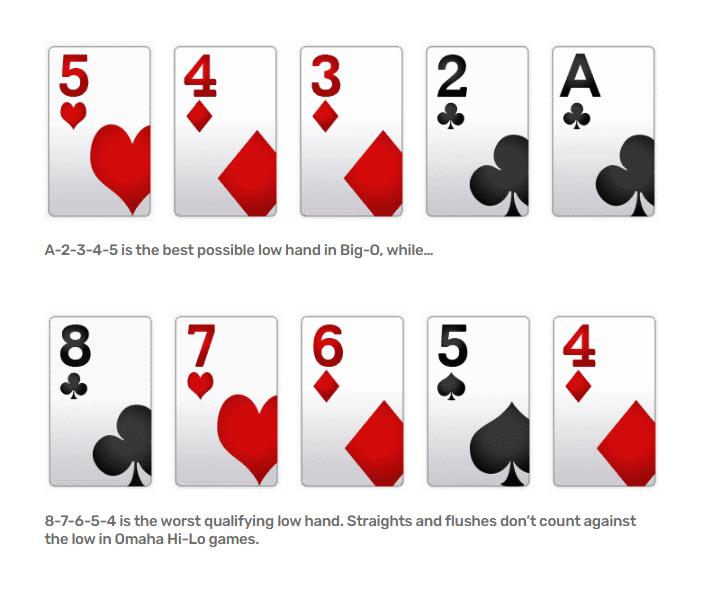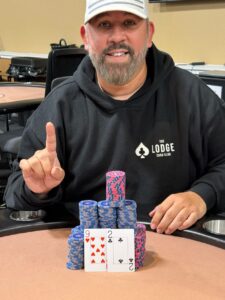Hang around the Lodge for any period of time, and you’ll likely notice a game called Big-O that’s very popular among players.
Big-O is a poker variant that’s played just like Omaha Hi-Lo, except each player gets five hole cards instead of four. Like all Omaha poker games, Big-O is a community card game, which requires players to use a combination of hole cards and community cards to make the best five-card hand.
You’ll see Big-O available at the Lodge in both cash game and tournament format. This article will discuss Big-O poker tournaments, often among the most popular multi-table tournaments (MTTs) on the Lodge schedule.
Big-O Poker Rules
Big-O plays as a five-card Omaha Hi-Lo game. That means each player gets five hole cards, and each hand plays out with three rounds of community cards known as the flop, turn, and river.
Omaha poker variants play very much like Texas Hold’em in terms of the betting rounds, as well as the blinds and button structure.
One critical difference between Omaha and Texas Hold’em is that in Omaha, players must use exactly two hole cards in combination with exactly three community cards to make the best five-card hand.
This rule differs from hold’em, in which players can use any combination of hole cards and community cards to make the best hand.
While most Omaha variants deal four hole cards to each player, Big-O games see each player get five hole cards. The extra hole card greatly increases the chances of someone at the table making a big hand.
Big-O plays with hi-lo rules, meaning each pot is split between the best high hand and the best qualifying low hand. Qualifying low hands must contain five cards that are all eight or lower. The best possible low hand is A-2-3-4-5 (straights don’t count against the low).
If no player has a qualifying low hand at showdown, the player with the best high hands takes the whole pot (aka “scoops” the pot).
For an expanded look at Big-O poker rules, check out this guide from the Lodge.

How Does A Big-O Poker Tournament Work?
You’ll find Big-O games running at the Lodge in both cash game and tournament formats. If you’re not familiar with one or both of these formats, it’s important to understand the differences between the two.
In a Big-O cash game, you buy in for an amount, and get chips equivalent to the cash value of your buy-in. You compete for the money that all players have put down on the table, and you can start or finish a session whenever you want.
A Big-O tournament is a bit different. You buy in for a predetermined amount, and get a set amount of chips. The tournament chips have no cash value.
The object of a tournament is to outlast other players by not losing your chips. Tournament payout structures generally pay anywhere from 10-20 percent of the player pool.
For instance, a tournament that has 100 players could pay the top 20 players. When the tournament gets down to 20 players (i.e. 80 players have lost all of their chips), those 20 players all receive some portion of the prize pool. The player that outlasts all others gets the first-place prize, which is the biggest share of the prize pool.
Big-O Tournaments At The Lodge
The Lodge weekly tournament schedule includes a Big-O tournament that runs each Monday night. Let’s take a look at the details of that tournament:
The Monday Night Big-O
- Buy-In: $80
- Starting Stack: 35,000 chips
- 40-minute levels (late entry allowed through Level 3)
- $3,500 guaranteed prize pool
- Unlimited re-entry allowed
The Monday Big-O tournament comes with an $80 dollar entry fee. That buy-in gets you 35,000 chips.
When the tournament begins, all players have 35,000 chips. The blinds start at 500/500, (500 for the small blind and 500 for the big blind) and increase every 40 minutes.
The increasing blinds are a requirement in poker tournament play, preventing players from just sitting around waiting for other players to bust out. The tournament structure for the Monday Big-O looks like this:
- Level 1: Blinds 500/500
- Level 2: Blinds 500/1000
- Level 3: Blinds 1000/1500
- Level 4: Blinds 1000/2000
- Level 5: Blinds 1500/3000
- Level 6: Blinds 2000/4000
- Level 7: Blinds 3000/6000
- Level 8: Blinds 4000/8000
- Level 9: Blinds 6000/12000
By Level 9, your 35,000 starting stack is worth less than three big blinds. All players in the tournament are forced to make some moves before their stack gets blinded out.
Late entry is allowed through the end of Level 3, meaning you can buy a 35,000 starting stack up until the completion of that level. The Monday Big-O allows unlimited re-entry, meaning that if you get eliminated before the end of late registration, you can buy back in with a new starting stack.
The tournament plays on until one player has won all of the chips in the tournament. That player wins the first-place prize.
The top 10 percent of players cash in the Monday Big-O. For example, a recent edition of the tournament saw 79 players enter, and the total prize money up for grabs was $5,882.
The final eight players remaining all made the payout ladder.
Final Thoughts On Big-O Tournaments
Big-O is one of the most popular games at the Lodge. With five hole cards available to each player, you’ll see hands play out that seem to defy the odds, but are fairly common in the five-card Omaha Hi-Lo variant.
A few things to keep in mind for Big-O Tournaments:
Omaha Hole Card Rules
As with all Omaha variants, players must use exactly two hole cards in combination with exactly three community cards to make the best hand.
This is a critical difference from Texas Hold’em, in which you can use any combination of hole cards and community cards. If four spades are on the board in Omaha, and you have one spade in your hand, that’s not a flush in Omaha.
Big-O Plays Under Limit Betting Rules
Big-O plays as a limit game, with set limits on how much any player can bet or raise on any street.
If the blinds are 500/1000, the betting limits for that level are 1000/2000. The 1000 is known as the “small bet” and the 2000 is known as the “big bet”.
For the preflop and flop betting rounds, the maximum bet or raise is 1000 (the small bet). On the turn and river, the maximum bet or raise is 2000.
All betting rounds are capped at a maximum of four bets in terms of maximum raise size. So for example, if the small bet is 1000, the maximum raise size is 4000. Once the active bet reaches 4000, no one else can raise; you must just call the 4000 to stay in the hand.
For more on limit betting structure, and how it compares to no-limit and pot-limit, check out this guide from Upswing Poker.
Big-O Is A Split Pot Game
Big-O is an Omaha Hi-Lo game, and as such you’ll often see pots that get chopped up between two or more players.
In any Big-O game, whether it’s a tournament or a cash game, your best starting hands are the ones that give you a chance to win both the high and the low. A preflop hand like A-A-K-3-2, for instance, can lead to many different scenarios where you get to scoop the pot.
Check out this Upswing Poker guide on Omaha Hi-Lo and several other poker variants for tips and strategy that you can use in a Big-O tournament:
Perfect Limit HoldEm and Omaha 8 Strategy – Beating a Dead HORSE Part 1



